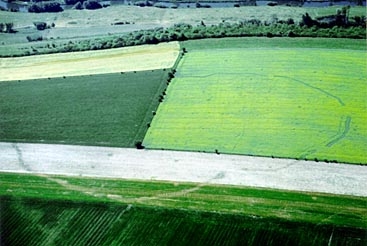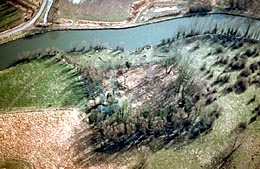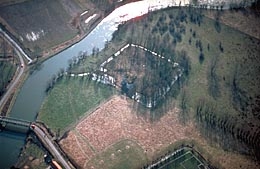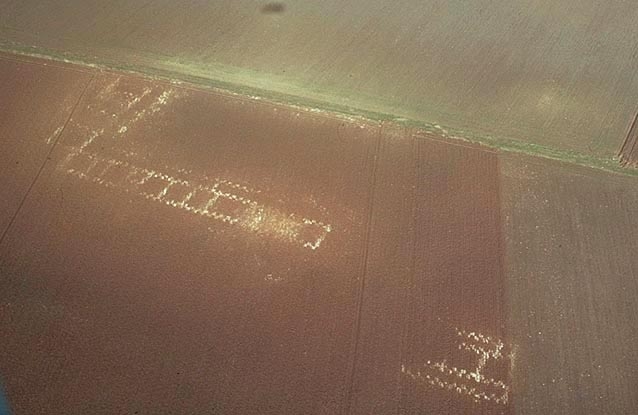- Home
- Clues on the ground
- Polymorphism
Large oval-shaped Neolithic enclosure at l'Étoile (Somme), at the place known as "La Justice". The ancient ditch takes on very different aspects depending on the type of crop.
Frequent variations
There are five clues that reveal buried sites:
- The landscape,
- Low-relief shadows,
- Crop growth anomalies,
- Ground moisture anomalies,
- Soil color anomalies.
These are theoretical, and change with the season.
In the course of a year, the same leveled-off site will appear often fleetingly, and its appearance will vary widely. Its polymorphism is frankly astonishing. In addition, a very slight change in the shot angle will give two photographs taken at the same moment completely different appearances. Thus, only the neat shape of the grove reveals the ancient fortified castle at Eaucourt (Somme). In the shot taken a few seconds later, however, a simple water reflection reveals the castle's moats. What is more, very slight variations in crop color and soil are visible only from a very specific angle. From directly above, or from another angle, they are completely invisible.
Only the triangular grove of trees reveals the location of the fortified castle. Eaucourt-sur-Somme (Somme).
The same sight during the same flyover at a slightly different angle. The reflection on the water in the ancient moat renders their layout remarkable clear.
Sometimes it happens that during the same photo session, a villa will take on entirely different appearances. This is the case at Froissy (Oise), in which the foundation lines are sharp when seen with the sun to one's back. Immediately afterwards, against the light, it is the ashy, humic zones that appear.
In agricultural plains, the same site that was revealed in the crops in the summer will reappear in the winter on bare ground, often sharper and more precise, with a polymorphism that is simply astonishing. Winter clues are easier to check and observe at ground level. This is why, in days gone by, farmers were sometimes disturbed by these fugitive appearances, which gave rise to legends and characteristic toponyms.
For example, a place known as "Le Champ des Neiges" [The Field of Snow] can signal the location of buried foundations, because snow lingers there a little longer. Other toponyms found in land registry indicate that the farmers had noticed the presence of leveled-off foundations, like for example "Les Pierriers" [The Stone Piles], "Les Tuileaux" [The Tiles], "La Briqueterie" [The Brick-Works] et plus souvent "Les Terres Rouges" [The Red Earth]. Traditions about buried treasure are also common, and especially tales about the appearance of ghosts, fairies, witch covens, etc.
Only the lines of the foundations of a part of the Gallo-Roman villa are clearly delineated. Froissy (Oise).
Same site, same flyover, but this time against the light. The foundation lines are no longer visible, only the dark, clayish zones.





